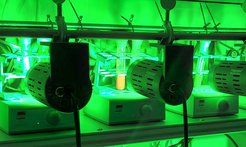Put into the right light – sustainable coupling reactions
Chemists at the Max Planck Institute of Colloids and Interfaces in Potsdam are developing improved methods for coupling reactions with light by targeted control of the catalyst activity.
A team of researchers reports in the journal Nature Catalysis that sustainable carbon-nitrogen cross-couplings can be performed using simple nickel salts, carbon nitrides and light instead of the precious metal Palladium. The chemists study the use of cost-effective and reproducible semiconductors as photocatalysts in coupling reactions.

Carbon-nitrogen cross-couplings are among the most important chemical reactions for the production of active pharmaceutical ingredients, crop protection agents and organic materials. In these reactions, two molecular building blocks are selectively linked together with the aid of a catalyst. Palladium compounds, which are considered excellent catalysts, are normally used for this purpose. However, due to the low abundance of this precious metal, these are expensive and not sustainable. Nickel is intensively studied as an alternative. However, this usually requires complex nickel complexes, strong bases or high temperatures.
Activation of simple nickel compounds by light and photocatalysts
These disadvantages can be avoided by activating simple nickel compounds with light and a photocatalyst. Suitable photocatalysts usually consist of rare and expensive precious metals such as iridium and ruthenium. In addition, the range of applications of these methods is limited and incomplete reactions as well as irreproducible results are observed.
Precious metal-free methods for reproducible carbon-nitrogen cross-coupling
In the course of their efforts to replace iridium and ruthenium photocatalysts with carbon nitrides, the chemists led by Bartholomäus Pieber discovered that the limitations and poor reproducibility are due to the destruction of the nickel catalyst, which can also lead to the deactivation of the photocatalyst. A careful analysis of these reactions enabled the scientists to prevent the destruction of the catalysts by selecting suitable light sources, changing the concentration or adding stabilizing additives. This has considerably expanded the range of applications for this reaction.
Bartholomäus Pieber, leading scientist of the research group "Catalysis", emphasizes: "The developed, precious metal-free coupling protocols open the way to cost-effective, sustainable and above all reproducible carbon-nitrogen cross-couplings, which can also be carried out with sunlight as an energy source. We will next test our methodology for the production of active pharmaceutical ingredients".
